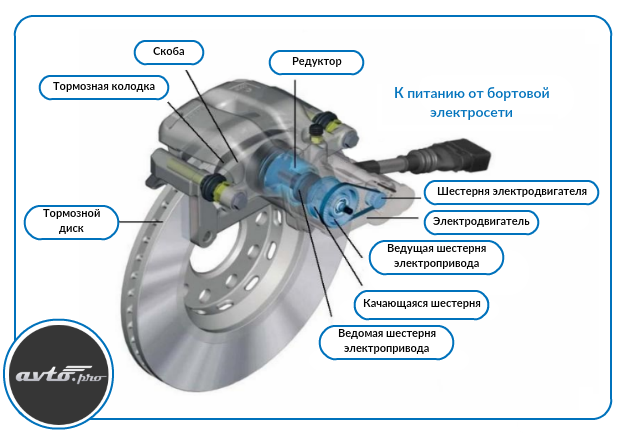
Description and types of brake fluid
Content
The basis of the brake system of the car is a volumetric hydraulic drive that transfers pressure in the master cylinder to the working cylinders of the brake mechanisms of the wheels.
Additional devices, vacuum boosters or hydraulic accumulators, which repeatedly increase the effort of the driver pressing the brake pedal, pressure regulators and other devices did not change the principle of hydraulics.
The master cylinder piston extrudes fluid, which forces the actuator pistons to move and press the pads against the surfaces of the brake discs or drums.
The brake system is a single-acting hydraulic drive, its parts are moved to the initial position under the action of return springs.
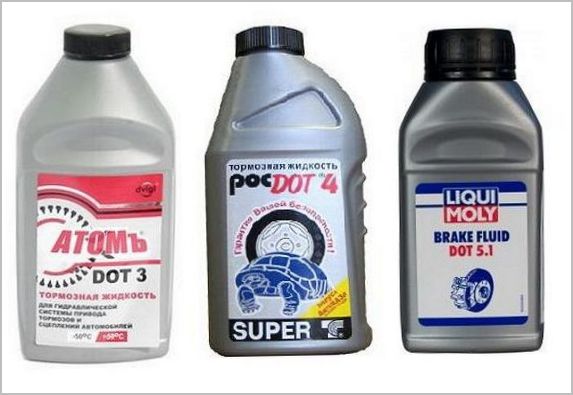
The purpose of the brake fluid and the requirements for it
The purpose is clear from the name - to serve as a working fluid for the hydraulic drive of the brakes and ensure their reliable operation in a wide range of temperatures and any operating conditions.
According to the laws of physics, any friction eventually turns into heat.
Brake pads, heated by friction against the surface of the disc (drum), heat the parts surrounding them, including the working cylinders and their contents. If the brake fluid boils, its vapors will squeeze out the cuffs and rings, and the fluid will be ejected from the system with a sharply increased pressure. The pedal under the right foot will fall to the floor, and there may not be enough time for the second “pumping”.
Another option is that in severe frost, the viscosity can increase so much that even a vacuum booster will not help the pedal to push through the thickened “brake”.
In addition, the TJ must meet the following conditions:
- Have a high boiling point.
- Retain the ability to pump at low temperatures.
- Possess low hygroscopicity, i.e. ability to absorb moisture from the air.
- Have lubricating properties to prevent mechanical wear of the surfaces of the pistons and cylinders of the system.
The design of pipelines of a modern brake system eliminates the use of any gaskets and seals. Brake hoses, cuffs and rings are made of special synthetic materials that are resistant to the grades of TJ provided by the manufacturer.
Attention! Seal materials are not oil and petrol resistant, therefore it is forbidden to use gasoline and any solvents for flushing brake systems or their individual elements. Use only clean brake fluid for this.
Brake fluid composition
In cars of the last century, mineral TJ was used (a mixture of castor oil and alcohol in a ratio of 1: 1).
The use of such compounds in modern cars is unacceptable due to their high kinetic viscosity (thicken at -20 °) and low boiling point (less than 100 °).
The basis of modern TF is polyglycol (up to 98%), less often silicone (up to 93%) with the addition of additives that improve the quality characteristics of the base, protect the surfaces of working mechanisms from corrosion and prevent oxidation of the TF itself.
It is possible to mix different TJs only if they are made on the same basis. Otherwise, the formation of emulsions that impair performance is possible.
Classification
The classification is based on international DOT standards based on the FMVSS temperature standard and the SAEJ viscosity classification.
In accordance with them, brake fluids are characterized by two main parameters: kinematic viscosity and boiling point.
The first is responsible for the ability of the liquid to circulate in the lines at operating temperatures from -40 ° to +100 degrees.
The second - for the prevention of vapor locks that occur during the boiling of TJ and lead to brake failure.
Based on this, the viscosity of any TF at 100°C should be at least 1,5 mm²/s and at -40°C - no more than 1800 mm²/s.
All formulations based on glycol and polyglycol are very hygroscopic, i. tend to absorb moisture from the environment.

Even if your car does not leave the parking lot, moisture still enters the system. Remember the "breathing" hole in the tank lid.
All types of TJ are poisonous!!!
According to the FMVSS standard, depending on the moisture content, TJs are divided into:
- "Dry", in factory condition and not containing moisture.
- "Moistened", having absorbed up to 3,5% of water during the service.
According to DOT standards, the main types of TA are distinguished:
- DOT 3. Brake fluids based on simple glycol compounds.
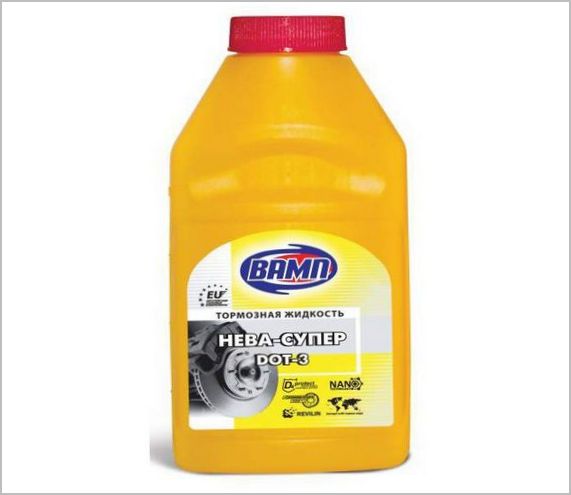
Boiling temperature, оFROM:
- "dry" - not less than 205;
- "moistened" - not less than 140.
Viscosity mm2/from:
- "moistened" at +1000C - not less than 1,5;
- "moistened" at -400C - no more than 1800.
They quickly absorb moisture and because of this, the boiling point is low after a short time.
DOT 3 fluids are used in vehicles with drum brakes or disc brakes on the front wheels.
The average service life is less than 2 years. Liquids of this class are inexpensive and therefore popular.
- DOT 4. High performance polyglycol based. The additives include boric acid, which neutralizes excess water.
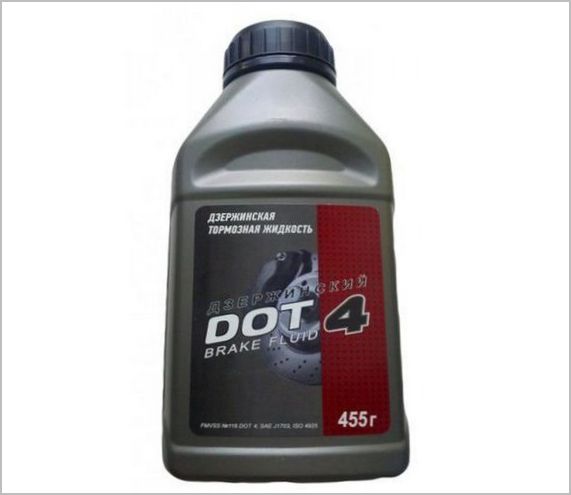
Boiling temperature, оFROM:
- "dry" - not less than 230;
- "moistened" - not less than 150.
Viscosity mm2/from:
- "moistened" at +1000C - not less than 1,5;
- "moistened" at -400C - no more than 1500.
The most common type of TJ on modern cars with disc brakes "in a circle."
Warning. All glycol-based and polyglycol-based TJs are aggressive towards the paintwork.
- DOT 5. Produced on the basis of silicone. Not compatible with other types. Boils at 260 оC. Will not corrode paint or absorb water.
On serial cars, as a rule, it is not applied. TJ DOT 5 is used in special types of vehicles operating at extreme temperatures.
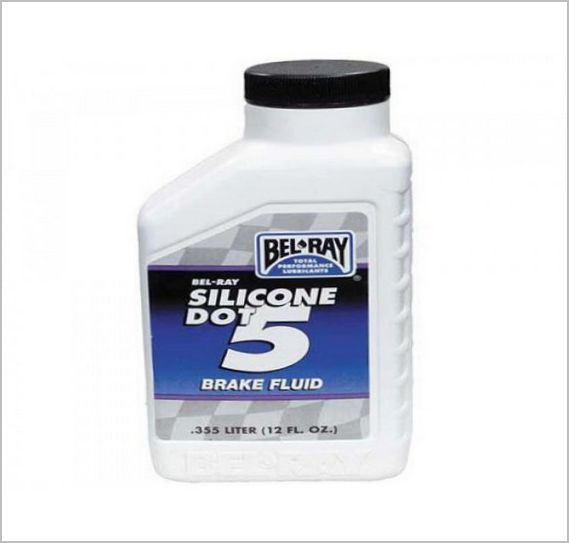
- DOT 5.1. Based on glycols and polyesters. Boiling point of "dry" liquid 260 оC, "moistened" 180 degrees. Kinematic viscosity is the lowest, 900 mm2/s at -40 оC.
It is used in sports cars, high class cars and motorcycles.
- DOT 5.1/ABS. Designed for vehicles with anti-lock braking system. Made on a mixed basis containing glycols and silicone with a package of anti-corrosion additives. Has good lubricating properties, high boiling point. The glycol in the base makes this class of TF hygroscopic, so their service life is limited to two to three years.
Sometimes you can find domestic brake fluids with the designations DOT 4.5 and DOT 4+. The characteristics of these fluids are contained in the instructions, but such marking is not provided for by the international system.
When choosing a brake fluid, you must follow the instructions of the vehicle manufacturer.
For example, in modern AvtoVAZ products, for the “first fill”, TJ brands DOT4, SAEJ 1703, FMSS 116 of the brand ROSDOT (“Tosol-Sintez”, Dzerzhinsk) are used.
Maintenance and replacement of brake fluid
The brake fluid level is easy to control by the max and min marks on the walls of the reservoir located on the main brake cylinder.
When the level of TJ decreases, it must be topped up.
Many argue that any liquid can be mixed. This is not true. DOT 3 class TF must be topped up with the same, or DOT 4. Any other mixtures are not recommended, and are prohibited with DOT 5 fluids.
The terms for replacing the TJ are determined by the manufacturer and are indicated in the vehicle operating instructions.
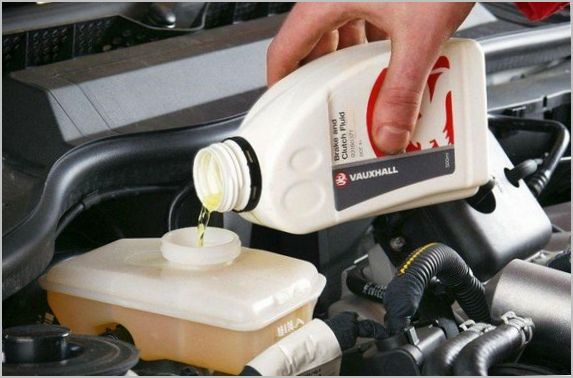
The "survivability" of liquids based on glycol and polyglycol reaches two to three years, purely silicone ones last up to fifteen.
Initially, any TJs are transparent and colorless. Darkening of the liquid, loss of transparency, the appearance of sediment in the reservoir is a sure sign that the brake fluid needs to be replaced.
In a well-equipped car service, the degree of hydration of the brake fluid will be determined by a special device.
Conclusion
A serviceable brake system is sometimes the only thing that can save you from the most unfortunate consequences.
If possible, monitor the quality of the fluid in the brakes of your car, check it in time and replace it if necessary.
